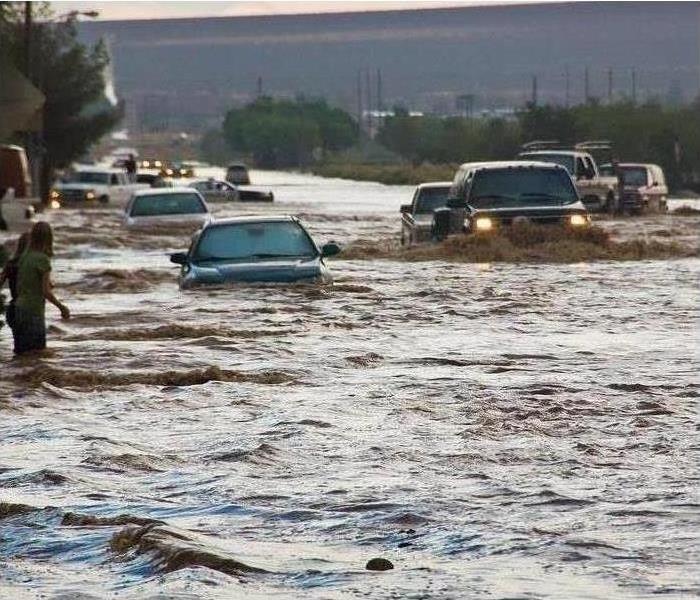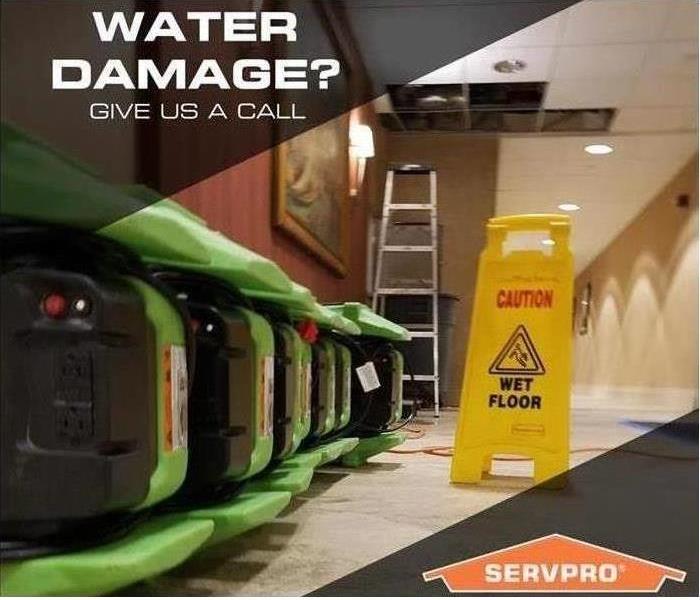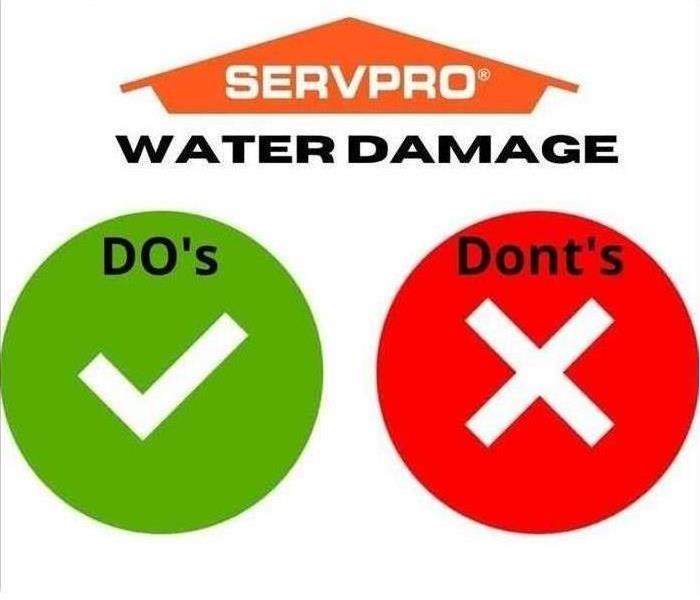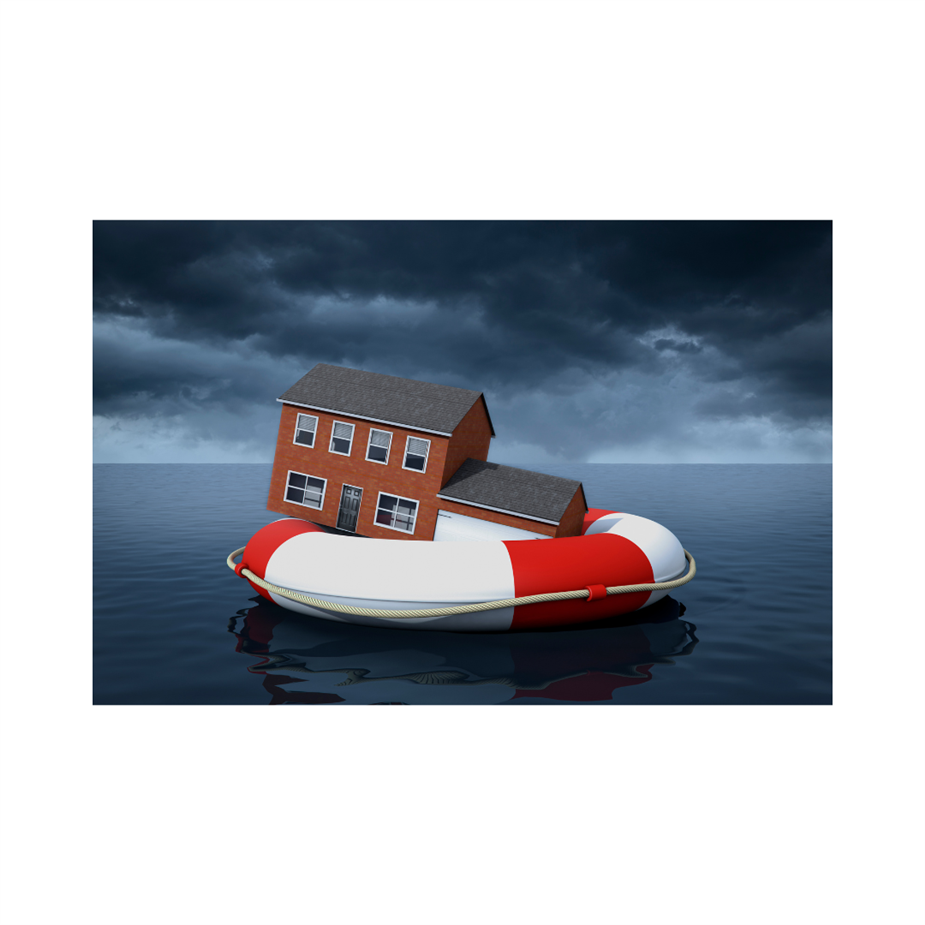Recent Posts
Top 4 Tips to Staying Safe During a Flood
3/3/2025 (Permalink)
Although it doesn’t rain often here in the Golden State, when it does, people aren’t always prepared for the worst. One of the worst situations you can find yourself in is being a victim to an unexpected flood that can destroy your car and house in a matter of minutes.
This is why it’s important to understand floods and how you can prepare yourself to protect your family and assets.
Even Though there are many types of flooding, these are the two main types you should be aware of:
1) Flash Floods
Flash floods occur when rainfall rises rapidly due to a lack of soil or vegetation which allows torrential rains to flow overland rather than penetrate the ground.
2) River Floods
River flooding is excessive rain that rises slower over a large area and develops from longer-lasting rainstorms, which is common in areas with wetter climate. Since Southern California is an area of dry climate and rocky terrain, it’s more prone to flash floods.
Here are some helpful tips to protecting yourself against a flash flood:
- Always be aware of your surroundings! Sometimes water can hit you from any direction.
- Avoid driving or walking through floodwaters. You never know what’s floating around in there.
- Move to higher ground as soon as you get a chance.
- If you happen to be in your vehicle when the flood hits, stay inside your car. If the water starts to rise, seek protection on the roof.
FUN FACT:
According to Ready, only 6 inches of moving water can literally push you down, and only ONE foot of moving water can sweep up your vehicle.
Enjoy the rain and stay safe!
For more information or help navigating a flood situation, reach out now and we would love to help you!
The 3 Types of Water Damages You Need to Know to Protect Your Home!
2/21/2025 (Permalink)
Being able to distinguish the type of water loss you are experiencing can help keep you and your family safe from hazardous contaminants and potential illness. And knowing which category your water damage is in gives you the insight you need on how to handle the damage until professionals arrive.
The three categories of a water loss are based upon the Institute of Inspection, Cleaning, and Restoration Certification(ANSI/IICRC S500). To start, the IICRC S500 considers both the originating source and what materials the water makes contact with to determine the range of contamination in water. The extent of the contamination in the water helps determine the category of the water loss.
The water originates from a sanitary water source such as broken water supply lines; appliance malfunctions involving water-supply lines; and melting ice or snow. However, a category 1 water loss may go up to a Category 2 or 3 based on the general cleanliness of the home, or if it passed through building materials, or contains an odor.
- Category 2: Contaminated Water
The water originates from sources such as a discharge from dishwashers or washing machines; overflows from washing machines; overflows from toilet bowls with urine but no feces; and broken aquariums. This water contains significant contamination and has the potential to cause sickness if contacted or consumed by humans.
- Category 3: Hazardous Water
The water is grossly contaminated and can contain toxigenic or other harmful agents. Examples of a category 3 water loss include sewage; toilet backflows; wind-driven rain; and flooding. For this type of water loss, you definitely want to wait for a professional to arrive as it is extremely dangerous to try to handle it on your own.
After you figure out which category you’re dealing with, follow these steps on What to Do (and Not to Do) During a Water Damage.
For more information or help navigating a water damage, reach out now and we would love to help you!
Restoring Property After Smoke Damage: A Step-by-Step Guide
2/12/2025 (Permalink)
Restoring Property After Smoke Damage: A Step-by-Step Guide
Smoke damage can be one of the most challenging effects of a fire. Even if your home or business didn’t suffer from direct flames, smoke can cause significant damage to your property. The odor, soot, and ash left behind by smoke can infiltrate walls, fabrics, and even hidden spaces, making it a tough cleanup job.
In this post, we’ll walk you through the process of restoring your property after smoke damage, explain the steps involved, and discuss why hiring SERVPRO of Irvine is crucial to bringing your property back to its pre-fire condition.
Understanding Smoke Damage
Smoke damage occurs when the byproducts of a fire—primarily smoke and soot—settle on surfaces throughout your property. Even small fires can produce significant smoke damage, as smoke particles are tiny and can travel long distances, affecting parts of your home that weren’t directly exposed to flames.
Smoke damage can affect many materials, including:
- Walls and ceilings: Smoke can penetrate into drywall, causing discoloration, odors, and weakening of materials over time.
- Fabrics and Upholstery: Sofas, curtains, rugs, and carpets can absorb smoke, making them smell musty or smoky.
- Furniture and Wood: Smoke can damage wood finishes, leaving behind a residue that discolors surfaces and potentially weakens materials.
- HVAC System: Smoke particles can travel through your air ducts, contaminating the entire system and spreading the odor and soot throughout the property.
Step 1: Safety and Inspection
Before beginning the restoration process, it’s crucial to ensure that your property is safe to enter. Fire can cause structural damage, so always have a professional fire restoration team inspect the property before you attempt to clean.
Once the property is deemed safe, the next step is to assess the extent of the smoke damage. This includes:
- Visual Inspection: A thorough examination of walls, ceilings, floors, furniture, and appliances will help identify areas affected by smoke residue and soot.
- Smoke Odor Test: Restoration professionals will check for lingering smoke odors, which are often pervasive and require specialized techniques to eliminate.
Step 2: Smoke Soot and Residue Removal
Soot, the fine black particles left behind by smoke, is one of the most challenging aspects of smoke damage. It can adhere to almost any surface, including hard-to-reach areas like ventilation ducts. Removing soot requires special tools and cleaning agents to prevent it from spreading further.
- Vacuuming: Restoration teams use HEPA vacuums to remove loose soot particles from walls, ceilings, and furniture. This is an essential first step in preventing the soot from being pushed further into porous surfaces.
- Dry and Wet Cleaning: Once soot has been vacuumed, professionals use specialized cleaning agents to break down the particles. For hard surfaces like walls and countertops, dry cleaning sponges and wet cleaning solutions may be used to lift soot from the surface without damaging the material underneath.
- Fabric Cleaning: Upholstered furniture, carpets, and curtains are often deeply affected by smoke. Professional cleaning may include steam cleaning, dry cleaning, or even specialized treatments to restore fabrics and remove trapped soot.
Step 3: Deodorization of Smoke Odors
One of the most stubborn problems caused by smoke is the lingering odor. The smell of smoke can penetrate walls, furniture, and fabrics, making it difficult to remove without the right methods. Professional restoration companies use several techniques to neutralize and eliminate smoke odors.
- Thermal Fogging: This process involves using a fogging machine to disperse deodorizing chemicals into the air, which attach to the smoke particles and neutralize them. Thermal fogging is particularly effective in porous materials like walls and upholstery.
- Air Scrubbers: To remove smoke from the air, air scrubbers equipped with HEPA filters are placed throughout the property. These machines help trap smoke particles and improve indoor air quality during the restoration process.
Step 4: Cleaning and Restoring HVAC Systems
Smoke particles often travel through your HVAC system, which can then spread the odor and soot throughout your home or business. Cleaning the HVAC system is a crucial step in smoke restoration. Professional cleaners will:
- Duct Cleaning: Technicians use specialized tools to clean ducts, removing soot and debris that can carry the smoke smell throughout the property.
- Replacing Filters: Smoke can clog air filters in your HVAC system. It’s essential to replace filters to prevent further contamination and ensure clean airflow throughout your space.
Step 5: Structural and Cosmetic Repairs
After the smoke, soot, and odors have been addressed, it’s time for any necessary repairs to your property. Depending on the extent of the damage, you may need to repair or replace:
- Walls and Ceilings: Smoke can penetrate deeply into drywall and cause discoloration or weakening of materials. These surfaces may need to be cleaned, repainted, or even replaced in some cases.
- Flooring: Smoke damage to flooring, especially carpets and hardwood floors, may require cleaning or refinishing. Carpets may need to be steam cleaned, while wood floors may require sanding and refinishing to remove smoke stains.
- Furniture: Upholstered furniture and wooden furniture can often be restored by professionals. Depending on the severity of the damage, this may involve deep cleaning, refinishing, or replacing the item.
Step 6: Prevent Future Issues
After the restoration process is complete, it's essential to take steps to prevent future smoke and fire damage:
- Install Smoke Detectors: Ensure that your property is equipped with working smoke detectors on every floor and near all sleeping areas.
- Fire Prevention Plan: Consider implementing a fire safety plan that includes fire extinguishers, fire-resistant materials, and clear evacuation routes.
- Routine Maintenance: Regularly maintain your HVAC system, keeping it clean and checking filters to ensure optimal air quality.
Why Hire Professionals for Smoke Damage Restoration?
Restoring a property after smoke damage is complex, requiring the right tools, knowledge, and experience. While DIY cleaning may seem tempting, smoke damage is persistent and can cause long-term problems if not addressed correctly.
Here’s why it’s best to hire SERVPRO of Irvine for smoke damage restoration:
- Expert Techniques: Professional restoration companies have the specialized knowledge and equipment to clean, deodorize, and restore your property effectively.
- Efficient Process: Smoke damage restoration can be time-consuming and labor-intensive. Professionals have the expertise to do the job quickly and efficiently, reducing the time you spend out of your property.
- Health and Safety: Smoke and soot can be harmful to your health. Professionals know how to safely handle and remove soot, smoke, and chemicals from your property to ensure your home or business is safe to inhabit once again.
Contact SERVPRO of Irvine for Smoke Damage Restoration Solutions
Restoring your property after smoke damage can be overwhelming, but with the right steps and professional help, you can bring your home or business back to life. By focusing on soot removal, deodorization, HVAC cleaning, and necessary repairs, you can ensure that your property is fully restored and safe for you and your family.
If you’ve experienced smoke damage, don’t wait—contact SERVPRO of Irvine to begin the cleanup process and get your life back to normal as quickly as possible.
What To Do (and Not to Do) During a Water Damage
12/22/2023 (Permalink)
1.What to Do (and Not to Do) During a Water Damage
Do you know what you would do if you found yourself standing in 3 inches of water in your living room? Well, don’t panic! First, to determine how to handle this situation, knowing what type of water you're dealing with is crucial.
The easiest way to look at it would be clean water vs. contaminated water.
Clean water can come from multiple sources such as toilet supply lines, dishwasher supply lines, an ice maker line to the fridge, or a hot or cold water supply line from your sink or shower. Essentially any source where the water does not encounter contaminates.
Contaminated water can come from a toilet overflow, roof leaks, slab leaks, or flood water. Essentially any source where the water encounters contaminates and potentially a high degree of waste.
When Handling Damage from Clean Water:
DO:
- Shut off the water source if possible
- Turn off circuit breakers for wet areas to keep yourself safe
- Remove as much water as you can by mopping it up
- Remove any valuables to a safe place to avoid damages (computers, paintings, documents, and any other sensitive materials)
DO NOT:
- Enter a room where you can experience electrical shock hazards
- Leave items such as books, newspapers, colored rugs, or other colored items on wet surfaces that may cause staining
When Handling Damage from Contaminated Water:
DO:
- Avoid contact with any sewage material or items affected by sewage
- Wash your hands if contact with contaminated items occur
DO NOT:
- Spread contaminated water by walking through wet areas
- Use household fans to try to dry the area
After handling the initial damage, reach out now and we would love to help you!
Leaving for Vacation?
12/19/2023 (Permalink)
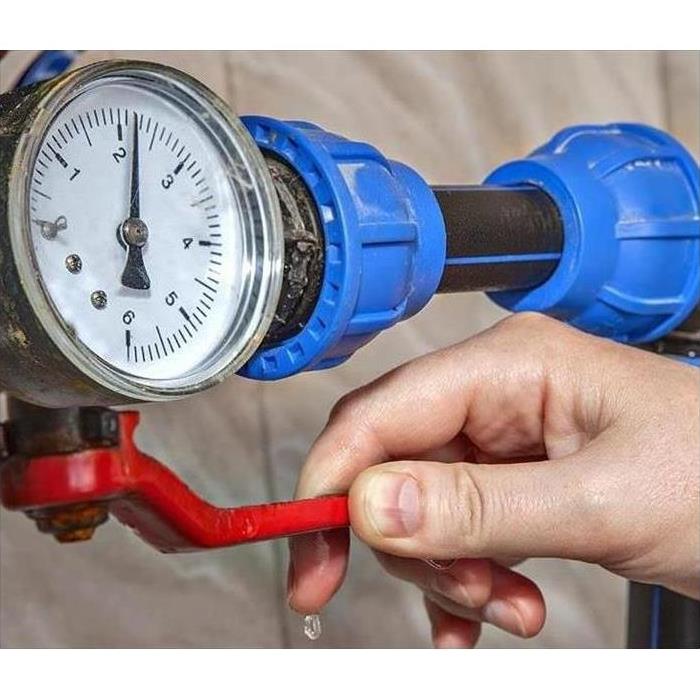 Turn the valve clockwise to shut off your water!
Turn the valve clockwise to shut off your water!
Ensure you come back to a proper home!
The holidays are coming up and maybe you’re dreading a conversation with your in-laws, or even worried about holiday surprises being spoiled. Whether it’s leaving the country or even driving away from your home for the weekend, one thing is for sure: you’ll be asking yourself, “Did I lock the door? Did I leave the stove on? Are the windows open?” These are all things to add to your checklist, but a common mistake is forgetting to turn off the main water.
You might be wondering, “Why would I need to turn off my main water supply?” Well, you wouldn’t want to come back to a flooded home! Now, it’s not as common as it may sound, but the possibility is still there. The smallest leaks can cause pipes or your supply lines to burst and start flooding your home. One single toilet supply line can produce up to 2-3 gallons of water per minute. In 24 hours that’s up to 2,000 to 3,000 gallons!
Turning off your main water supply
The main water supply is supplied by the city, and is normally located either in the front of the house or by the side. It can be identified by a red valve, along with a water meter or a regulator with a psi meter. Turn the valve clockwise and it’ll shut off your main water supply. Simple as that!
SERVPRO of Irvine 24 Hour Emergency Water Damage Service
12/13/2023 (Permalink)
SERVPRO of Irvine is available 24 hours a day for water emergencies, large or small. When you are dealing with water damage, immediate action is crucial. A delay of just a few hours can greatly increase the severity of the water damage.
We Answer the Phone Ready to Help!
Call Today – (949)474-7776
We understand that when you call us, you may be feeling confused, stressed, and vulnerable. You need an expert to guide you through this crisis. SERVPRO of Irvine has the specific water damage training and experience to help you through this tough time. We specialize in water damage restoration—in fact, it's the cornerstone of our business.
What to Expect:
When you call, we will ask several questions regarding your water damage emergency. These questions will help us determine what equipment and resources to bring, including how many trained SERVPRO professionals may be needed.
Our SERVPRO Representative will ask several questions:
- Your name and contact information
- Your insurance information (if applicable)
- The street address of the water-damaged home or business
- When did the flooding or water damage occur?
- What caused the water damage (if known)?
- Is there electricity available (on-site)?
- About SERVPRO of Irvine
About SERVPRO of Irvine
SERVPRO of Irvine specializes in the cleanup and restoration of residential and commercial property after a fire, smoke or water damage event. Our staff is highly trained in property damage restoration. From initial and ongoing training at SERVPRO’s corporate training facility to regular IICRC-industry certification, rest assured our staff is equipped with the knowledge to restore your property.
Flood Insurance in California! Is it Worth it?
10/3/2022 (Permalink)
Out of 365 days of the year, California experiences sunny weather for 284 days. So what is the point of getting flood insurance when there is so little rain?
To start, mortgage companies may require you to purchase flood insurance as part of the loan agreement, especially if your house is in a flood zone. A common mistake that some homeowners make is thinking that their home insurance covers flood, but that’s not always the case - and sometimes you don’t find that out until it’s too late.
If you run into a flood scenario without insurance, you may have to pay an upfront payment for this kind of water damage, which could cost you up to $10,000.
To most people’s surprise, flood insurance is affordable and usually purchasable through the National Flood Insurance Program. The average cost for an insurer is $793 per year and the options can be tailored to your home and flood zone.
A flood insurance policy covers several risks faced by California homeowners:
1) Overflow of inland and tidal waters, such as rivers that can flood during heavy rain.
2) Mudflow over areas that are normally dry
3) Levee breaks
Something to keep in mind is that events such as a sinkhole or landslide will not be covered by the NFIP flood insurance policy. This will require additional coverage, for example, earthquake insurance.
So the big question, is it worth it?
According to the California Department of Water Resources, every county in California has experienced a federally declared flood disaster within the past 20 years.
These floods have caused rivers to overflow and damage thousands of homes at a time. These damages can easily cost thousands of dollars that you would have to pay out of pocket instead of having a portion of it covered by insurance. So unless you have a significant rainy day fund, it would be worth it to buy flood insurance to avoid unnecessary fiscal stress.
For more information or help navigating a flood situation, reach out now and we would love to help you!
Top 3 Tips To Keep Your Home Safe From A Flood!
9/14/2022 (Permalink)
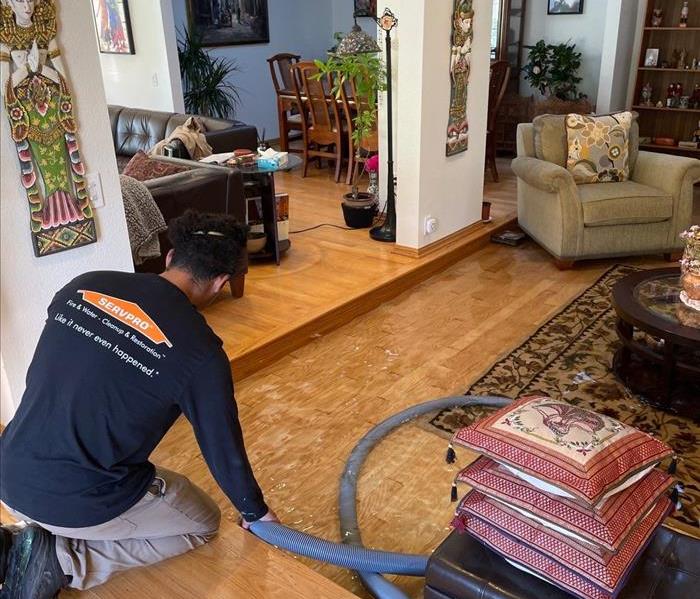 This flooded area was caused by a storm.
This flooded area was caused by a storm.
Although it doesn’t rain often here in Orange County, when it does, people aren’t always prepared for the worst. One of the worst situations you can find yourself in is being a victim to an unexpected flood that can destroy your home in a matter of minutes.
This is why it’s important to understand floods and how you can prepare yourself to protect your family and assets.
Even though there are many types of flooding, these are the two main types you should be aware of:
1) Flash Floods
Flash floods occur when rainfall rises rapidly due to a lack of soil or vegetation which allows torrential rains to flow overland rather than penetrate the ground.
2) River Floods
River flooding is excessive rain that rises slower over a large area and develops from longer-lasting rainstorms, which is common in areas with a wetter climate. Since Southern California is an area of dry climate and rocky terrain, it’s more prone to flash floods.
Here are 3 helpful tips for protecting your home from a flash flood:
- Keep those gutters clean! The most common reason homes begin experiencing a flood is because their first method of defense is dirty. Make sure all parts of the gutters are cleared from debris, especially the downspout!
- Purchase sandbags or flood barriers to keep large moving waters from entering your home! Having either of these at entrances such as the front door or garage will keep water from flooding through.
- Make sure the storm drain is cleared from debris. Usually, during a storm or flood, large amounts of debris is collected along the flow of water. Well, that debris gets carried to your nearest storm drain (located on the street) and clogs it up!
FUN FACT:
According to Ready, only 6 inches of moving water can literally push you down, and only ONE foot of moving water can sweep up your vehicle.
Enjoy the rain and stay safe!
For more information or a free consultation call 949-474-7776
What To Do When Your Toilet Overflows
7/18/2022 (Permalink)
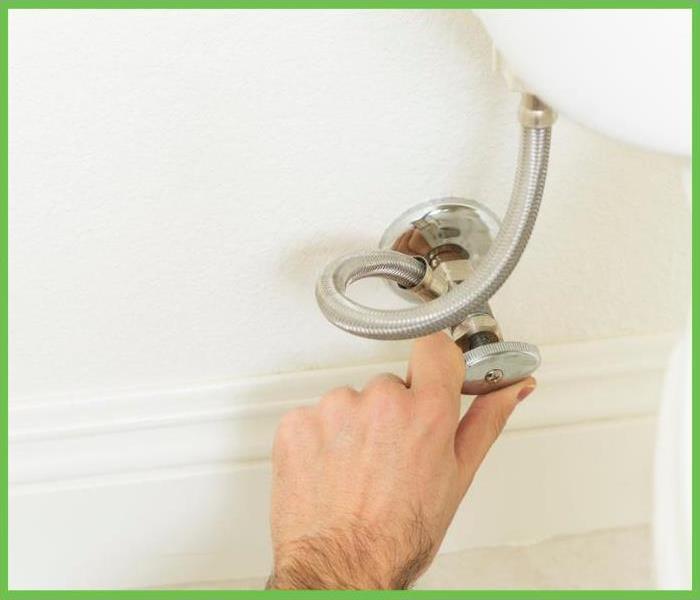 This photo shows the location of the toilet water supply line. Turn clockwise to shut it off.
This photo shows the location of the toilet water supply line. Turn clockwise to shut it off.
3 Easy Steps: What to Do When Your Toilet Overflows
What to Do When Your Toilet Starts Overflowing
Picture this: Just as you are leaving the bathroom, you hear the undeniable, dreaded sound of water hitting the floor. Looking back, you see the toilet overflowing! You turn off the water—but what do you do now? Any person’s natural reaction would be to panic, but by knowing what to do in this scenario, you can protect yourself and your home or office while also reducing any feelings of fear and anguish that may arise.
When Handling a Toilet Overflow:
1.Cut off the toilet’s water supply
By finding the valve on the wall behind the toilet, and turning it clockwise, you can cut off the toilet's water supply. These can be found behind the toilet and looks like a silver fixture coming out of the wall with a knob in the front. If there is no valve behind the toilet, take the top off the tank and lift the float ball or cup high enough to stop the water from running. Then shut off the water supply to the house with the main valve or knob located near the water heater. By turning off the water, you prevent any additional fluids and contamination from exiting your sewage system (as well as reducing any potential odors that may occur). If the water is severely contaminated upon examination, avoid the area, turn off the HVAC system and contact our expert staff.
Did you have an overflowing toilet?
Call 949-474-7776 now for a free consultation from a restoration specialist near you.
2. Clean Up the Water and Waste from the Floor
Water soaks fast into walls and cabinets, and waste spreads germs and causes mold. The longer the contaminated water remains on your bathroom floor, the more harm it can do. Mop up any remaining water and waste as soon as possible to avoid mold growth and more damage. The quality of your flooring and other amenities in the affected area will be preserved by removing any water that escapes from your drainage system. While appropriate ventilation will aid in the evaporation of the water, depending on the amount of water and the severity, you may want expert assistance.
3. Disinfect to Avoid Bacterial Growth
Finally, the area should be disinfected and sanitized to ensure no bacterial growth occurs and all surfaces are safe for contact and use. Start by cleaning everything with soap and warm water. After that, disinfect everything by mixing one cup of bleach with a gallon of water and wiping it down. Not only will this eliminate mold and germs, but it will also aid in the removal of any odor.
Without a doubt, everyone wants to avoid a toilet overflow. They must be dealt with immediately for the safety of your bathroom and your health. SERVPRO IRVINE is prepared to tackle these circumstances by removing any moisture and odors using our modern equipment and techniques while also implementing our goal of returning your area to its previously undamaged state. With our 24/7 open guarantee, we will ensure a rapid and ready team to tackle the job and return your bathroom to its functional, clean state. For more information or help navigating a flood situation, reach out now and we would love to help you!



 24/7 Emergency Service
24/7 Emergency Service
